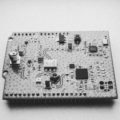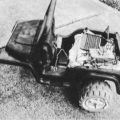DRFM Radar Jammer
This was my senior design project. I worked with two other guys on this and we built a simple, toy DRFM jammer demonstration platform. It uses a USRP as the jammer and the MIT coffee can radar. Here are some pretty pictures: 
The radar
On the left is a plot of distance vs time with clutter rejection and shows a person walking away and the towards the radar. The plot on the right is without clutter rejection.
Resulting plots from jamming. You can see in the plot on the left returns from an object that appears to be starting at a range of about 100m and closing in on the radar, however nothing is actually there and this is the result of transmitting back at the radar. This happens several times, but is strongest the first time. The second image on the right shows how swamping the receiver with noise blocks any potential returns.
This demonstrates an effect that we couldn’t quite explain. On the left is a capture without clutter rejection. On the right is a capture WITH clutter rejection, but it’s more noisy. We think this is because we exploited a poor filter choice, but we’re not sure. We didn’t have time to investigate, but if you have a theory, let me know!
There are huge quantities of documentation I wrote, so I’m going to link them here rather than reproduce it all. For a quick overview, you can check out the poster we made:
Senior Design Poster. Download [PDF]
More detailed documentation:
Senior Design Technical Review Paper on DRFM. Download [PDF]
Senior Design Proposal on Electronic Countermeasures for Radar. Download [PDF]
Senior Design Preliminary Design Review presentation. Download [PDF]
Senior Design Final Report. Download [PDF]
Here’s the Matlab code we wrote to see live returns from the radar:
https://github.com/blueintegral/CoffeeCanRadar
This is based off the code originally written by Gregory Charvat, who also designed the original coffee can radar.
More info if you want to build your own:
http://www.glcharvat.com/Dr._Gregory_L._Charvat_Projects/Cantenna_Radar.html
http://ocw.mit.edu/resources/res-ll-003-build-a-small-radar-system-capable-of-sensing-range-doppler-and-synthetic-aperture-radar-imaging-january-iap-2011/projects/
http://en.wikipedia.org/wiki/Digital_radio_frequency_memory
I also designed an antenna for this project, but we never ended up using it. It was a circularly polarized panel antenna. Here’s what it looked like: Antenna [PDF]
And here are the characteristics of it. I designed this in HFSS using the antenna design wizard.












